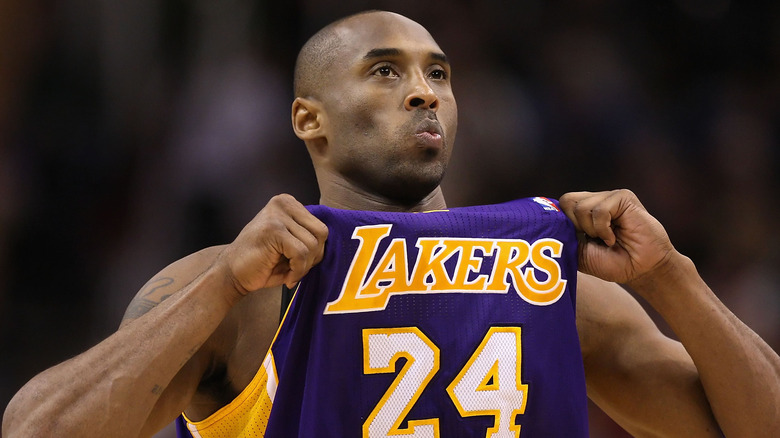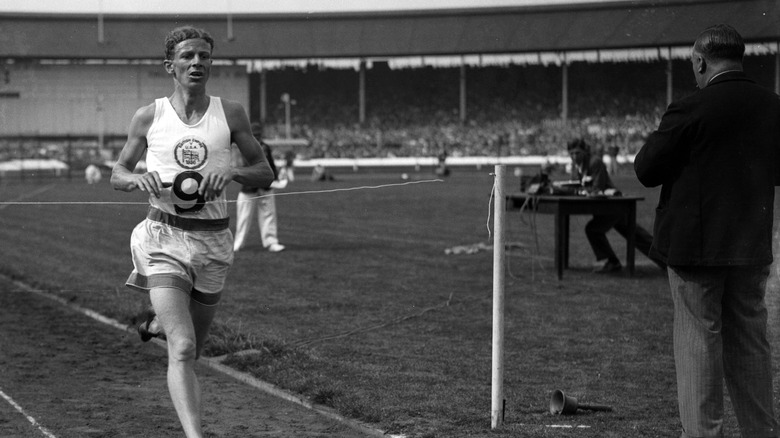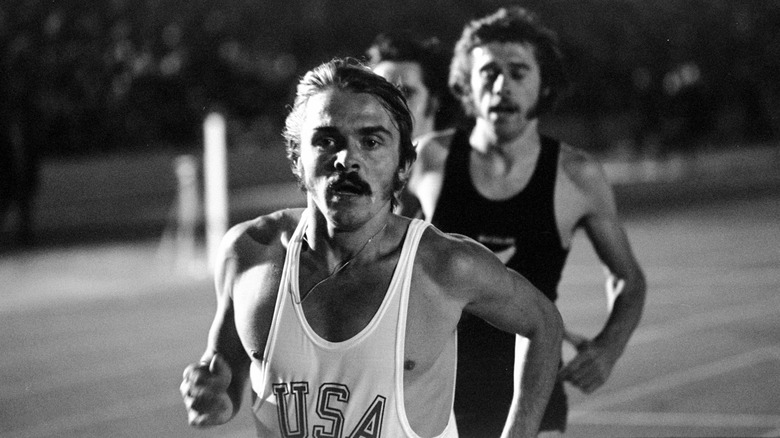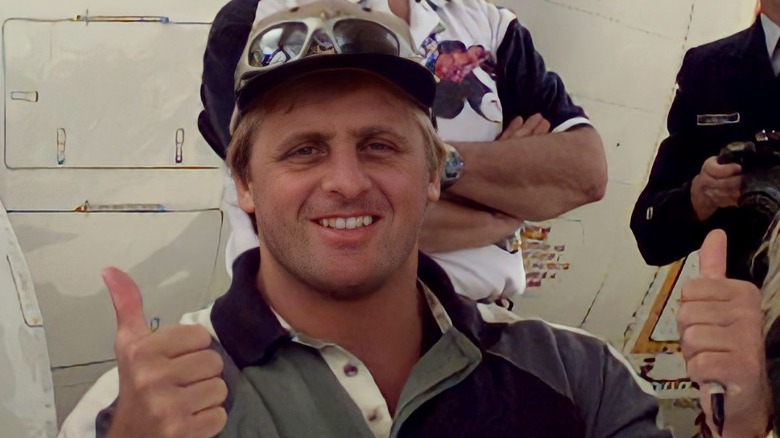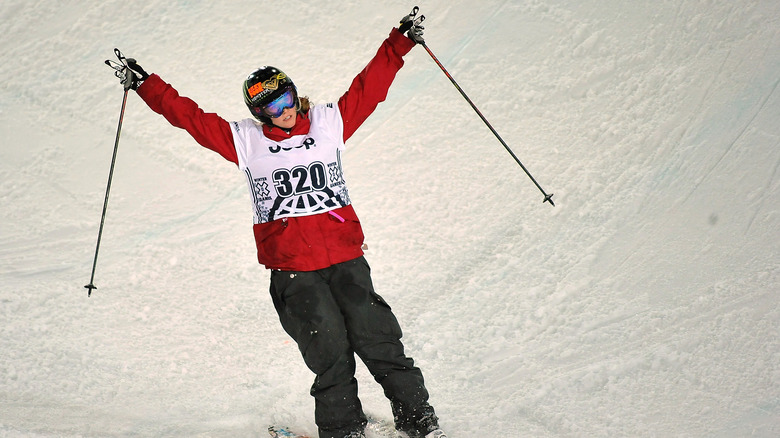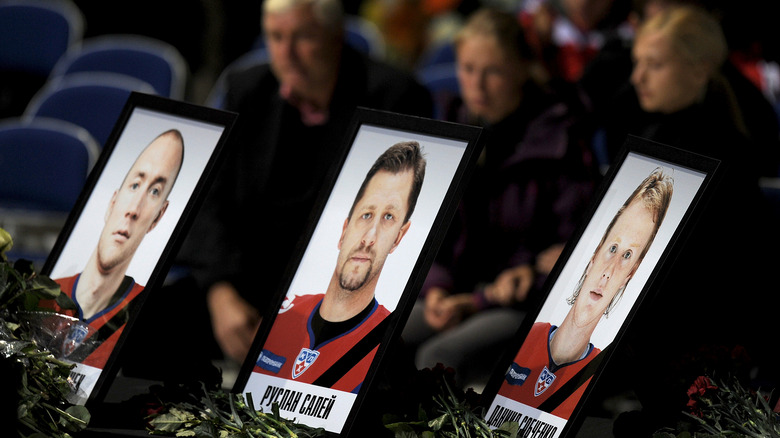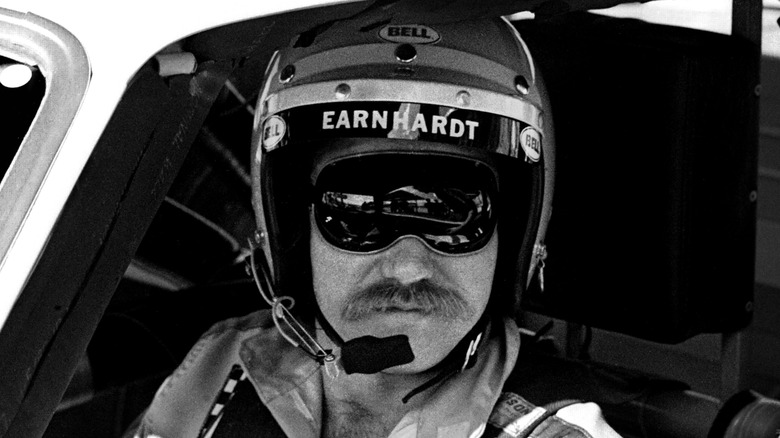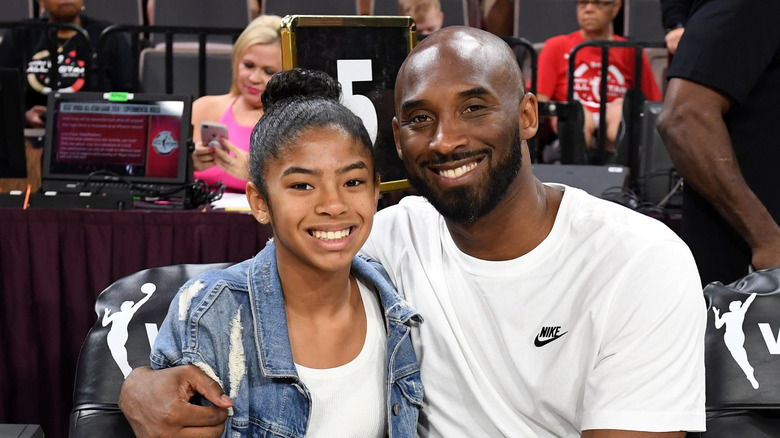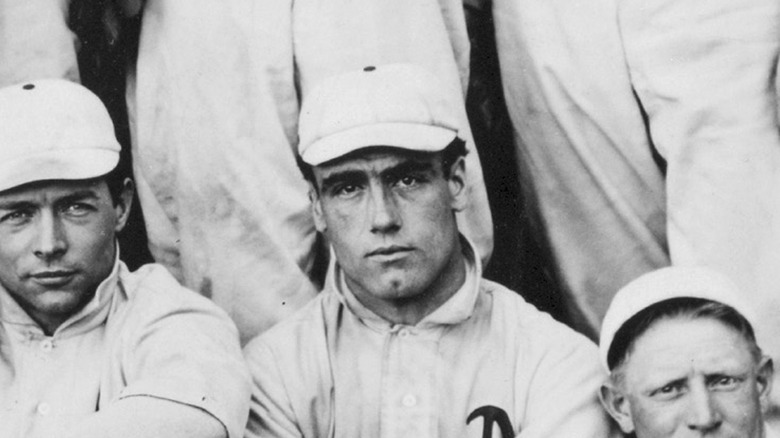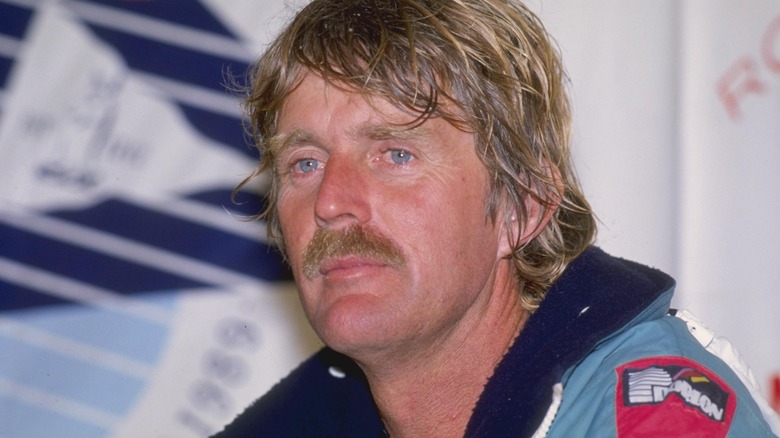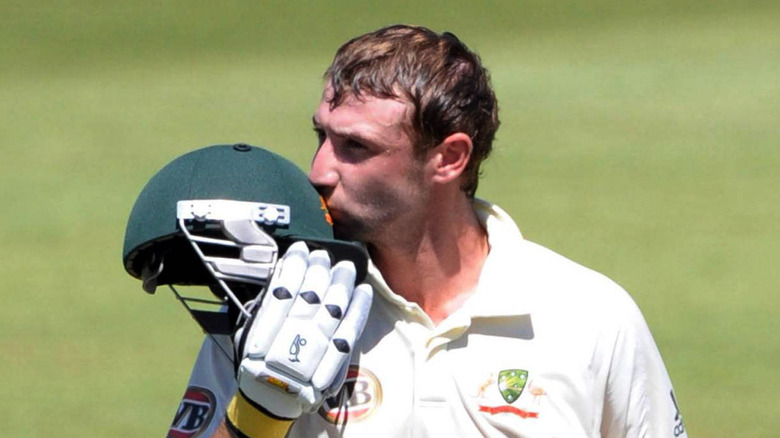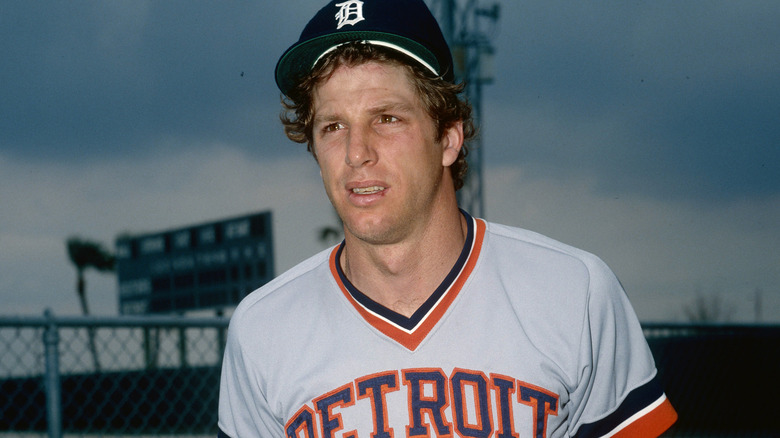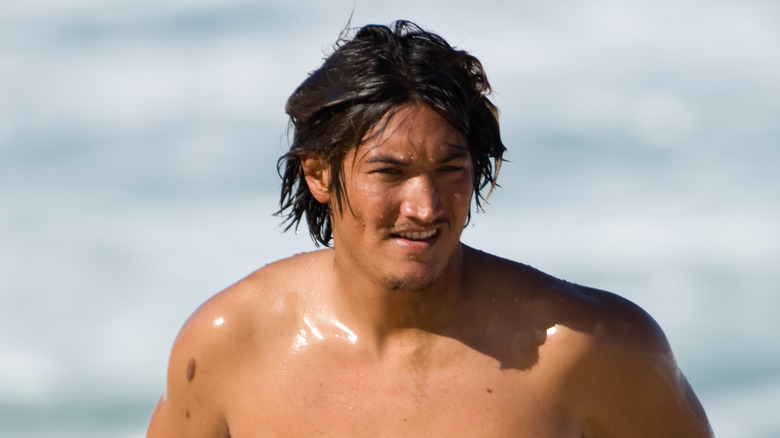Sports Stars Who Died In Freak Accidents
Correction 05/13/22: A previous version of this article stated that Scott Boras was Nick Adenhart's manager, and that Sarah Burke was a four-time Olympic gold medalist. Boras was Adenhart's agent not his manager, and Burke was a four-time X Games gold medalist, not an Olympic medalist.
Sports are fun and healthy. But professional athletes tend to be folks who push themselves to their physical limits, live life on the edge, and thus put themselves, fairly routinely, in harm's way. Injuries in the world of sports are obviously common. How many careers have been brought to an abrupt end by blowing out a knee or taking one too many hits to the head? Still, folks in peak physical shape have a reasonable expectation of at least surviving such injuries, and many recover completely and return to the sport.
But the athletes on this list weren't quite so lucky. The accidents they suffered weren't routine or predictable, and none of them, sadly, had a chance to recover. Some accidents happened on the field. Others didn't. Getting hit in the head by a 95 mph fastball, crashing a bike into a stray dog, tumbling to the ring after the suspension cable got loose, rolling a convertible, dying alongside the entire team in a freak plane crash — all of these stars died in tragic sports accidents.
Raymond Chapman
Today, batting helmets are required, but they haven't been around forever. In fact, in the 1920s, nobody wore them at all.
Raymond Chapman (pictured, center), a Cleveland Indian who was at bat on August 16, 1920, while battling the New York Yankees on their home turf, found out the hard way why anything less than fully protective headgear won't do (via History). A pitch by Yankee Carl Mays struck Chapman in the temple, sending him to the dirt. By the next morning, he was gone. Thankfully, he's the only player in MLB history who's ever died after getting hit with a pitch (despite the fact that even after the tragedy, no team required its players to wear helmets for another two decades, and the league as a whole didn't require them until the '70s).
There was another factor here that contributed to Chapman's demise: the spitball. Now banned, the spitball was formed when the pitcher spat on the ball to alter its path and make it tough to hit. Other techniques that accomplished the same thing were rubbing dirt on the ball or even cutting it up to the point that it would be destroyed by the end of the game. Mays himself was infamous for these practices — and for occasionally hitting batters. Regardless, it wasn't until Chapman collapsed that Mays realized the sound of the ball wasn't from hitting the bat but the head of the man who was bleeding from the ear.
Joaquim Agostinho
Imagine training your entire life for something spectacular and being so close to achieving what so many seek — only to have it all ruined at the last possible second because a single stray dog is on walking the street.
Portuguese cycling hero Joaquim Agostinho sadly didn't have to imagine. According to a team he rode for, Flandria Bikes, Agostinho was a six-time consecutive Portuguese biking champion who finished the Tour de France 12 of the 13 times he participated and had won numerous other accolades. But it all came to an abrupt, tragic end on April 30, 1984. Agostinho, then just 41 years old, was nearing the finish line of a race when a stray dog wandered onto the path. The Portuguese racer tried to swerve but couldn't, collided with the poor animal, and crashed into the pavement head first, suffering serious wounds. Memim Encyclopedia claims he actually got back on the bike afterward and even finished the race before undergoing surgery 10 hours later in Lisbon, Portugal's capital. But the injury was far more serious than he was willing to admit, and 10 days after fracturing his skull in the accident, he passed away (via The New York Times).
|Featured image by Miklog via Wikimedia Commons|Cropped and scaled|CC BY 3.0|
Jack Lovelock
Jack Lovelock was a husband, father of two little kids, and working as a medical professional by the time his 30s were coming to an end in 1949 (via New Zealand History). But most people — especially from his native New Zealand — remembered him as a record-breaking track and field pioneer and an Olympic hero who nabbed his home country its first-ever gold medal at the summer games.
By the mid-1930s, though, Jack Lovelock's career aspirations in medicine and several injuries — including chronic knee pain certainly traceable to his running career — forced him to hang up the sneakers once and for all. But the problems didn't stop. In the early 40s, for example, he fell from a horse, hit his head, and was unconscious for an astonishing two days, if not longer. Perhaps unsurprisingly after such an injury, dizziness and eyesight issues would plague Lovelock for the rest of the life he was lucky to still have — and would likely play a major role in his 1949 death.
According to New Zealand History, Lovelock was standing on a train platform just days before the end of the decade on December 28 when he called his wife, saying he felt too unwell to go to work. He would never make it home. Sick and dizzy, Lovelock fainted and fell onto the train tracks. Mercifully, the oncoming train killed him instantly.
Bill Masterton
Between the cold, the sharp skates, the fistfights, the speed of the players, and the hard surface they'd smack into if they fell, it's no surprise that hockey players deck out in layers upon layers of protective padding. And yet, in the 1960s, when Bill Masterton was playing, helmets were not a requirement (per ESPN).
One fateful game, Masterton's skates got tangled up with the stick of an Oakland Seals player. He then lost his balance and tumbled into another player, who inadvertently knocked Masterton hard. The Minnesota North Stars center then fell backward and smashed his head on the unforgiving ice. "We watched his head bounce," said a fan who saw the tragedy from the stands, per ESPN. "He didn't move after that. It got deathly quiet." Fellow North Stars player André Boudrias said of the incident: "It sounded like a baseball bat hitting a ball. His eyes were gray at the time — it was like a horror picture. I knew he was done."
At the hospital 30 hours later, Masterton's parents and wife made the heart-wrenching decision to pull him off life support. He was 29 and remains the only player to die of injuries sustained during an NHL game. The league later introduced the Bill Masterton Memorial Trophy to commemorate his perseverance and determination in the league, though a helmet requirement being imposed earlier than it was — more than 10 years after the tragedy — might have been a better tribute.
Steve Prefontaine
As Sports Broadcasting points out, runner Steve Prefontaine made an impact that punched well above the weight class his single, relatively unspectacular Olympics appearance would suggest. After all, he didn't even have a medal at the time and would never return. And yet, the long-distance athlete — a high school prodigy and peerless college performer (he even nabbed the cover of Sports Illustrated at age 19) — inspired countless young runners to dust off their sneakers and hit the road. He was later the subject of multiple movies, and he ultimately became a major influence on the explosion of popularity the sport of long-distance running enjoyed in the 1970s.
In light of all that, it's no surprise that his death devastated the running community and the world at large. In 1975, with multiple records and awards under his belt and no reason he couldn't dominate the next summer Olympics (and in the midst of a protracted battle with the influential Amateur Athletics Union), Prefontaine rolled his convertible and became pinned beneath it. He was gone before help could arrive.
"He was so open and inviting," said Sports Illustrated writer and Olympic runner Kenny Moore (per The Seattle Times). "He had the crowd. There was nothing like him. ... We all feel something when the crowd goes crazy, but he gave more. It's a matter of degrees. No one gave as much as he did."
Nick Adenhart
It's always tragic when athletes are cut down in their prime. But there's something particularly sad about an athlete who meets their demise right after their career has begun. In the case of 22-year-old Nick Adenhart, who'd just joined the Los Angeles Angels in 2009, he even had to recover from a serious elbow surgery to get where he was.
Then, through no fault of his own or the others in his car, his story came to an abrupt, violent end when they were T-boned by a drunk driver in a minivan who had just run a red light, as per ESPN. Adenhart died during surgery, two other passengers died on the scene, and a fourth ultimately made a hard recovery. The driver, unscathed, fled the scene but was arrested later that night.
At the next Angels game against Boston, Nick's father, Jim, walked out onto the pitcher's mound, stood in silence before the crowd, and covered his face with his hands. Angels manager Mike Scioscia said (via ESPN), "It is a tragedy that will never be forgotten." At a press conference, Adenhart's agent Scott Boras, wept, saying, "He told his dad that he'd better come here, that something special was going to happen. He was so elated ... he felt like a major leaguer."
Owen Hart
Just because a lot of pro wrestling is staged doesn't mean it isn't dangerous. Those are often real holds, body slams, and chairs being smashed into backs, and competitors can suffer severe lifelong injuries and even death, according to Bleacher Report. But as Canadian pro wrestler Owen Hart (known in the ring as "Blue Blazer") found out in 1999, these tragedies can even occur before the match has started.
About 75 minutes into a televised event, Hart was being lowered into the ring to compete in front of 16,000 spectators at Kansas City's Kemper Arena, per CNN. Then, eyewitnesses claim the cable holding him up either snapped or disconnected, sending the wrestler tumbling 50 feet. He died after hitting his head on impact. Mercifully, pay-per-view audiences didn't see the tragedy, as they were watching a highlight reel of Hart's greatest moments.
Paramedic Michelle Hindorff, who rushed to the scene after the accident, commented that she didn't think the cable snapped. "He was supposed to be lowered down into the ring. It didn't get hooked on to him," she said, per CNN. "He thought it was hooked on." Perhaps unsurprisingly, the audience didn't initially realize it wasn't just part of the act. "We thought it was a doll at first," 15-year-old Robert McCome told the outlet."We thought they were just playing with us. We were really shocked when we found out that it was no joke."
Sarah Burke
According to The New York Times, Canadian skier Sarah Burke had successfully pulled off a 540 Flat Spin in a 22-foot halfpipe countless times in other practice runs before her final attempt. While it certainly was beyond the ability of folks like us, she'd all but mastered the move, to the point that she had a reasonable expectation of landing it — and certainly surviving — for years to come.
Tragically, her January 2012 attempt would be her last. The tumble she took after landing certainly didn't look threatening, and The New York Times even uses the word "innocuously" to describe the way her head hit the ground. Far from it: She didn't get up after the fall, and when others rushed to her side, they noticed she had no pulse and wasn't breathing. Nine days later, at age 29, she died of hypoxic ischemic encephalopathy (HIE) — a condition in which oxygen deprivation leads to brain damage — in the hospital she'd been airlifted to.
Burke's loss was a stunning blow to her loved ones, anyone even tangentially involved with her sport, and the Winter X Games. The tributes that poured in noted that the four-time X Games gold medalist had been highly influential, successfully pushing to have the half-pipe added to the Olympics. "She was doing a trick she was well versed in," said Peter Judge, CEO of the Canadian Freestyle Ski Association (via The New York Times). "The conditions were good, and everything seemed normal. That mitigates a lot of that sort of introspection."
The entire Lokomotiv hockey team
You would be absolutely stunned — and heartbroken — to learn just how many promising athletes have been killed in airplane or helicopter crashes. CNN compiled a list to satisfy the morbid curiosity of those reeling from Kobe Bryant's death in January 2020. But while the NBA superstar's passing was easily the most famous such event, one of the deadliest is a 2011 plane crash in Yaroslavl, Russia, that killed 44 out of the 45 people on board. In an instant, the entire Lokomotiv hockey team ceased to exist.
The Hockey News' Adam Proteau names some of the victims: Brad McCrimmon, Igor Korolev, Alexander Karpotsev, Kãrlis Skratinš, Ruslan Salei, Karel Rachunek, Josef Vašíček, and Pavol Demitra. And those were just some of the players — dozens of other members and coaches and assistants were lost. In an instant, wives were widowed, children lost their fathers, and parents lost their children. International hockey felt the loss too. "Although Lokomotiv eventually moved forward after the tragedy and iced a KHL squad again," Proteau writes, "the spirit of those who perished still surrounds the team. It really doesn't feel like it's been a decade since we lost them. The pain is still raw for their friends, family, and teammates."
The entire Bena Tshadi football team
"Lightning killed at a stroke 11 young people aged between 20 and 35 years during a football match" might be the single strangest news headline you've ever read. But it's exactly what the daily newspaper L'Avenir in Kinshasa in the Democratic Republic of Congo reported in October 1998, according to The Guardian. It happened in the eastern province of Kasai, in the middle of a tied soccer match between the Bena Tshadi team and the visiting team, Basanga. Even stranger is the fact that while 30 other people sustained injuries in the strike, that visiting team, despite being on the same field where their opponents all died, escaped without a scratch.
So how could a blast kill all members of one team and leave all members of another unhurt when they're all tangled up together? It's unclear. Nevertheless, The Irish Times points out that the civil war the country was embroiled in at the time made it hard to determine exactly how the freak accident happened.
Dale Earnhardt
ESPN says that 2001's Daytona 500 race was the most anticipated event in NASCAR history. Ads were everywhere, including expensive TV spots during the NFL playoffs. The event would, of course, end up being one of the most talked-about races in the sport's history, but not for the reasons anyone hoped.
Even if you weren't a NASCAR fan, Dale Earnhardt was inescapable. ESPN points out that despite several serious recent injuries, including a broken collar bone, the seven-time Winston Cup champ had no respect for safety guidelines. He called a proposed carbon fiber neck brace a "damn noose" that he wouldn't wear and made a point not to appear at an event where NASCAR officials brought in an automotive safety expert to pitch its benefits.
It might've saved his life. On turn 180 of the big race, Earnhardt's Monte Carlo crashed into a concrete barrier after colliding with another driver. The impact instantly knocked between 42 to 44 mph off his initial speed of 160 mph, and 60 gs worth of force inflicted numerous injuries on the famed driver, including a fatal spinal injury near the neck. Just 80 milliseconds later, he was dead.
"Having Dad was like a cheat sheet," Dale Earnhardt, Jr., then 24 and now an acclaimed champion in his own right, remembers thinking. "Like knowing all the answers to everything. And I was like, 'Man, I'm going to have to do this without that for the rest of my life.'"
Kobe Bryant
This is one of those events where you probably remember exactly where you were when you heard about it. According to The New York Times, Kobe Bryant — the five-time NBA championship-winning, 18-time All-Star Los Angeles Lakers legend — was onboard a helicopter with his 13-year-old daughter, Gianna. Bryant was heading up to Thousand Oaks to coach his daughter's basketball team with seven other passengers when the vehicle crashed northwest of Los Angeles; no one on board survived the violent impact. According to another article from The New York Times, other victims included an experienced pilot, a baseball coach, some other young basketball players, and their parents and family members.
As reported by NBC Los Angeles, moments of silence, speeches, artwork, memorials, trending tweets, public services, and more covered the planet and the internet as peers, celebrities, and fans paid tribute. Gold and purple were everywhere for months. And if you think about it, we never got a chance to properly mourn and come to terms with the January 26, 2020 tragedy. In hindsight, it looks like a chilling sign of all the terrible things that year was about to bring, from an impeachment (no, not that one, the other one), to a brutal election, to impassioned civil rights demonstrations, to a deadly pandemic that took millions of lives and sent the global economy crashing.
Doc Powers
Sources disagree on what exactly happened on April 12, 1909, when the Philadelphia Athletics played its inaugural game in Shibe Park, and over the next two weeks. Mike "Doc" Powers — so nicknamed because he was a licensed physician off the field — played his usual position of catcher in the game, and it's said that when keeping his eye on the ball while attempting to catch a pop-fly, he didn't notice a wall of the behemoth new stadium and crashed right into it. But according to other accounts of the time, Powers stretched too hard to snag a high pitch to the extent that he suffered an intestinal dislocation. At any rate, Powers stayed in the game and the next day reported that his significant physical discomfort was the result of indigestion from a cheese sandwich eaten before the start of the game.
Over the next two weeks, Powers' health detonated to the point where he sought medical attention, possibly even immediately after the game. Some sources claim he endured so many internal injuries from running into a wall that he required three surgeries. What is definitely true is that toxic gangrene developed in his intestines, and it killed the baseball player at the age of 38 — and if the alleged causes are true, it would be the first time a Major Leaguer would die from injuries suffered in a game.
Peter Blake
Peter Blake was a champion yachtsman and one of the greatest sport sailors of all time. Over a three-decade career in the 1970s, '80s, and '90s, he won every major championship and event in top-level race-sailing, including the America's Cup, and the captain of Team New Zealand once set a record for the speediest time to sail around the world.
After dining with his ship's crew at a restaurant in the Amazon River delta city of Macapa, Brazil, in December 2001, Blake returned to his boat, a Seamaster yacht. Shortly after arriving, a rubber raft occupied by what eyewitnesses said was as many as eight men approached the ship and boarded. They demanded Blake hand over property; he refused and fired his gun, prompting the gang of river pirates to unload their firearms in response. Two members of Blake's crew suffered injuries in the melee, while Blake died from his wounds. A judge in Brazil later sentenced six pirates to 20 years in prison each for their role in the death of the 53-year-old sailor.
Vitas Gerulaitis
The son of a Lithuanian national champion, Vitas Gerulaitis was born in Brooklyn and raised to be a tennis star, training at elite academies before joining the professional tennis circuit's singles division in 1971 at age 17. In the late 1970s and 1980s, he stood among the era's superstars. Gerulaitis was ranked in the top 10 men's players worldwide from 1977 to 1983, during which time he fared well in Grand Slam events. In 1977 alone, he won the Australian Open, lost a semifinal at Wimbledon to Bjorn Borg, and nearly took the U.S. Open against John McEnroe. When he retired in 1985, Gerulaitis had won 27 total tournaments and about $2.8 million in prize money.
At about noon on Sunday, September 18, 1994, Gerulaitis was discovered dead in the guest home on a friend's property in Southampton, New York. Investigators later cited the cause of death as accidental poisoning via carbon monoxide. Fatal levels of carbon monoxide were found throughout the residence, believed to have originated from an improperly operating propane heater. Fumes entered the air conditioner and heating system, then traveled to where Gerulaitis was sleeping, which he unknowingly inhaled. The tennis player was 40 years old.
Payne Stewart
After turning professional in 1981 and joining the PGA tour, Payne Stewart spent nearly two decades as one of the most consistent and competitive golfers around. He qualified for 465 tournaments, finishing in the top 10 a whopping 130 times, and winning 11 times. The most significant of those victories: the 1991 U.S. Open. Stewart fared particularly well in international play, with multiple tournament wins in Japan and four appearances on the U.S. Ryder Cup squad.
In October 1999, Stewart, along with three colleagues and two pilots, boarded a small, two-engine Learjet in Orlando, bound for Dallas. Authorities believe that just after takeoff, the chartered plane suffered a sudden and unexpected loss of cabin pressure. That led to a deadly lack of oxygen, and the medical condition that resulted, hypoxia, almost instantly killed everyone on board, including the 42-year-old Stewart. Dispatched military planes tracked and followed the plane, which ran on autopilot until it crashed after running out of fuel.
Phillip Hughes
In the pitch-and-hit sport of cricket, an extremely popular team sport in Asia and English Commonwealth nations, Phillip Hughes was a superstar in the making. The wicketkeeper and opening batter for Sheffield Shield in Australia's top professional division, at age 19 he became the youngest player to score 100 runs in a final. An aggressive batsman and frequent scorer, he racked up multiple offensive accomplishments and looked to have a long pro cricket career ahead of him.
During a November 2014 match for the Sheffield Shield, Hughes faced New South Wales paceman Sean Abbott who delivered, or bowled, a bouncer — the ball is meant to strike the ground and then come back up to reach a height to where the batsman can properly strike it. Usually a highly controlled maneuver, the bouncer instead struck Hughes hard on the neck. He lost consciousness and was rushed to St. Vincent's Hospital in Sydney, suffering from a brain hemorrhage. Hughes failed to regain consciousness and died about 48 hours after the on-pitch accident. He was 25 years old.
Mark Fidrych
Mark Fidrych caused a sensation when he took the pitcher's mound for the Detroit Tigers in 1976. Known for his quirks — superstitiously hopping over boundary lines, talking to the ball, scratching around on in the dirt, wandering around the field — as much as he was his accomplishments, the 21-year-old went 19-9 with an ERA of 2.34 and 24 complete games, leading both leagues in the former and the American League in the latter. He'd be named the AL's Rookie of the Year and a starting pitcher at the All-Star Game. One of the most recognizable baseball players of the era, "Bird," so nicknamed because his tall, lanky figure and thick curly yellow hairstyle earned comparisons to Big Bird from "Sesame Street," injuries would sadly lead to Fidrych's exit from pro baseball in 1980.
In April 2009, a friend visited Fidrych on the latter's farm in Massachusetts and found the former pitcher's lifeless body underneath a dump truck. An investigation by the state medical examiner determined Fidrych's death was accidental and complicated. While attempting to repair the vehicle, Fidrych's clothes got caught up in the truck's power takeoff shaft. That part rotated and trapped Fidrych underneath, crushing him. He was 54.
Mikala Jones
Hawaii-based surfer Mikala Jones started out in his sport in 12-and-under divisions in the 1980s, eventually progressing to the amateur circuit where he won two national titles. As a touring surfer who competed throughout Asia, Micronesia, and Africa, he became a frequent target for surf photographers before he became one himself. Jones surfed as a way to further his art, capturing spectacular photos and videos from the point of view of a surfer from inside and underneath those giant ocean waves and the water tunnels they create, something he documented on his well-followed Instagram account.
On the morning of July 9, 2023, Jones was surfing off the Mentawai Islands, off the coast of Sumatra, in Indonesia. During the excursion, Jones experienced a surfing mishap he didn't survive. He wiped out in such a unique and dangerous way that the fin of Jones' board made contact with the surfer's femoral artery, and with such pressure and speed that it cut into the blood-moving channel. Located in the thigh, the femoral artery is one of the largest blood vessels in the body and supplies the legs. The cut was so devastating that Jones couldn't be saved; the surfer was 44.
Adam Johnson
A star hockey player and two-season veteran of the Pittsburgh Penguins of the NHL, Minnesota-born forward Adam Johnson joined the Nottingham Panthers of the U.K.'s Elite Ice Hockey League in 2023. On October 28, 2023, he played in an early season match against the Sheffield Steelers at that team's Utilita Arena.
During the second period of the game, Johnson and an opponent violently crashed into one another. In the midst of that, the opposing player's skate sliced into and through Johnson's neck. He immediately went down, and officials called off the game and ordered fans out of the arena. Medical personnel rushed Johnson to a nearby hospital where he died of his severe injury that day. He was 29. Local South Yorkshire Police announced they would open an investigation into Johnson's death, while governing body the English Ice Hockey Association announced that as of January 1, 2024, it would require players to wear neck guards.
